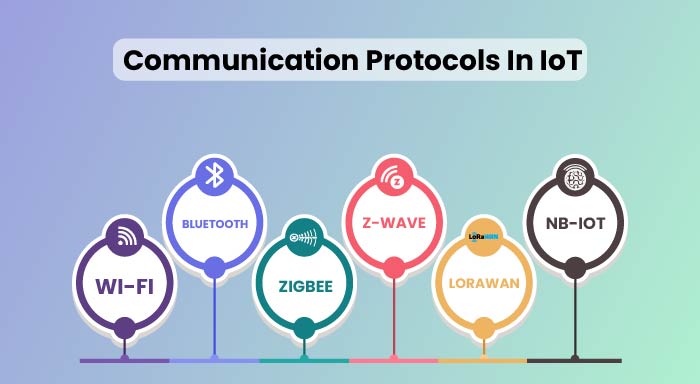Introduction
In the realm of the Internet of Things (IoT), communication protocols in IoT serve as an essential link that enables devices to connect, share data, and work together effortlessly. These protocols dictate how IoT devices interact and ensure a seamless communication, data accuracy, and synchronization across the network. Among the numerous IoT communication protocols, some of the most widely recognized include Bluetooth Low Energy (BLE), Zigbee, MQTT, NB-IoT, Z-Wave, LoRaWAN, and WiFi.
These standardized communication frameworks are really very important for managing interactions between devices to enable efficient data transmission, and drive a reliable network performance. In order to these key aspects of IoT communications, this article will enlighten you with the concept of IoT communication protocols, highlighting key protocols and their unique configurations that are driving the future of IoT connectivity.
The Importance of IoT Communication Protocols
Interoperability: A Fundamental Requirement
As mentioned above, in the ever-progressive world of IoT, different manufacturers' devices should be able to work in harmony to realize the full potential of the Internet of Things. Here, they also become universal interfaces that define a way of communication between devices from different vendors and create an environment where all these devices can be interconnected.
Energy management and Utilization efficiency
Most of the IoT devices may require energy sources like batteries or energy scavenging methods. Transmission procedures are vital to the approach of conserving power, which will allow gadgets to last for a longer time without often replacing or recharging their batteries.
What Is IoT | Internet of Things?
History of IoT: Analyzing the Origins of IoT
Scalability and Reliability
With millions of new devices being connected daily, problems of scale arise and protocols used for inter-device communication need to be prepared to scale as well without compromising the fidelity of the information being exchanged. Reliable procedures guarantee that information is transmitted consistently and quickly while a weak signal or interference is present or unavailable.
Prevalent Communication Protocols in IoT
Wi-Fi (IEEE 802. 11)
Wireless fidelity technology also known as Wi-Fi is based on the IEEE 802. Included in IEEE 802. 15. 4 standard, which comprises 11 standards, WiFi has seen massive adoption in consumer IoT applications. It provides premium-speed data transmission and is compatible with smartphones, laptops, smart home devices, and more.
Bluetooth Low Energy (BLE)
Bluetooth Low Energy (BLE) is created for low power consumption and short-range transferring, and it is suitable for IoT devices with longer battery lifespans, like fitness trackers, smart locks, and beacons. BLE runs in the 2.4 GHz frequency band and has up to 100 meters transmission range.
ZigBee
Specifically, ZigBee is a mesh network designed for IoT applications that involve low power and low data rates. It works in the 2.4GHz and sub-GHz frequency bands, making it capable of supporting thousands of devices in a single network. This marks ZigBee as a mesh topology network where data can be passed through different nodes thus enhancing the network’s coverage and stability.
Z-Wave
Z-Wave is also a protocol that operates at low power and low data rates optimized for home automation systems and smart homes. Works in the sub-gigahertz frequency range and is less susceptible to interference from other types of wireless systems.
LoRaWAN
LoRaWAN is one of the communication protocols in IoT, that supports low-power long-range communication in IoT networks known to have a wide range. It works in the sub-gigahertz frequency band, and can provide coverage of several kilometers; therefore it can be useful in applications such as smart metering, asset tracking, and environmental monitoring among others.
NB-IoT
Narrowband Internet of Things (NB-IoT) is a Low Power Wide Area Network (LPWAN) that is being standardized by the 3GPP. It works in licensed cellular frequency bands and utilizes the LTE networks and infrastructure which makes the solution more cost-effective for massive IoT usage.
MQTT and CoAP: Lightweight Protocols for IoT
The IoT protocols include Message Queuing Telemetry Transport (MQTT) and Constrained Application Protocol (CoAP), which are built explicitly for constrained devices at the IoT levels.
MQTT is a publish-subscribe messaging protocol that enables efficient data exchange between devices and servers, making it suitable for real-time monitoring, sensor data collection, and remote control of IoT devices.
CoAP, on the other hand, is a web transfer protocol based on the REST architecture, providing a lightweight alternative to HTTP for machine-to-machine communication. It is often used in building automation, industrial control systems, and sensor networks.
Emerging Trends and Future Directions
As the IoT ecosystem expands the complex and new needs appear, and this defines the creation of the new protocols and standards for the IoT network.
1. Strengthened Protection and Information Safety
Owing to the rising use of IoT devices and the connections between them, as well as the personal and sometimes sensitive information that these devices collect and process, the issue of protection has emerged as crucial. They are creating protocols that will allow for secure encryption and authentication of networks due to the increasing threats of cyber attacks.
2. AE: Edge Computing and Fog Networking
Edge computing and fog networking architectures provide solutions to work closer to the source data and analyze them to lower latency and bandwidth issues. This approach thus requires agreed-up protocols for the exchange of data between edge devices and the cloud.
3. Standardization and Interoperability Efforts
Currently, there are efforts by organizations and consortiums to come up with open standards that will enable devices from different manufacturers to have common protocols. This collective effort is looking forward to making the Internet of Things more innovative, more efficient, and achieving its full potential.
Conclusion
Communication protocols In IoT constitute the foundations of the Internet of Things as they allow devices to send information and interact. Being aware of the features and possibilities of these protocols it is possible to make the right choices and design IoT devices and platforms with their help that would meet the technical needs of various applications. While IoT is still in its early stage, the progress in standard bodies, implementation, and security will be critical in shaping the future development and application of this revolutionary technology for the benefit of man and his environment.
FAQs - Communication protocols In IoT
What is the Z-Wave range?
Z-Wave is a wireless communication technology that eliminates the need to tear up carpets and floors in order to connect new wiring. It works by using dependable, low-power radio waves that can readily pass through walls, floors, and furniture.
What is the range of Zigbee?
The typical range of Zigbee wireless technology is approximately 10-100 meters (33-328 feet) in line-of-sight conditions.
What is LoRaWAN good for?
LoRaWAN is good for transmitting small payloads (such as sensor data) over great distances.
What is the difference between LTE and NB-IoT?
NB-IoT devices can be somewhat less expensive in the end than LTE-M devices because of the higher complexity and superior latency that LTE-M offers. NB-IoT is not intended for mobility, whereas LTE-M is. For stationary devices that don't require VoLTE for reduced connection, NB-IoT networks are ideal.
How many devices can Z-Wave support?
A Z-Wave network can support up to 232 nodes, or devices, in total, including the main controller.
What is a Bluetooth Low Energy BLE antenna?
The Bluetooth Special Interest Group (Bluetooth SIG) developed and markets Bluetooth Low Energy (also known as Bluetooth LE, BLE, or simply Bluetooth), a wireless personal area network technology with innovative uses in home entertainment, security, beacons, healthcare, and fitness.
How accurate is Zigbee?
Zigbee is generally considered to be a reliable and accurate wireless communication protocol, but its accuracy can vary depending on several factors.
Is Zigbee better than Wi-Fi?
Although the Zigbee protocol operates at substantially slower speeds than WiFi, the devices consume significantly less electricity as a result. The range of Wi-Fi devices is greater than that of Zigbee devices. On the other hand, you can get a greater total range by using these devices to relay signals.
Realted Posts
Learn the Ideas Behind the Logical and Physical Designs of IOT
What Are The Functional Blocks of IoT Devices & Their Functionalities?
Internet of Things | IoT Design Methodology And Its Importance



